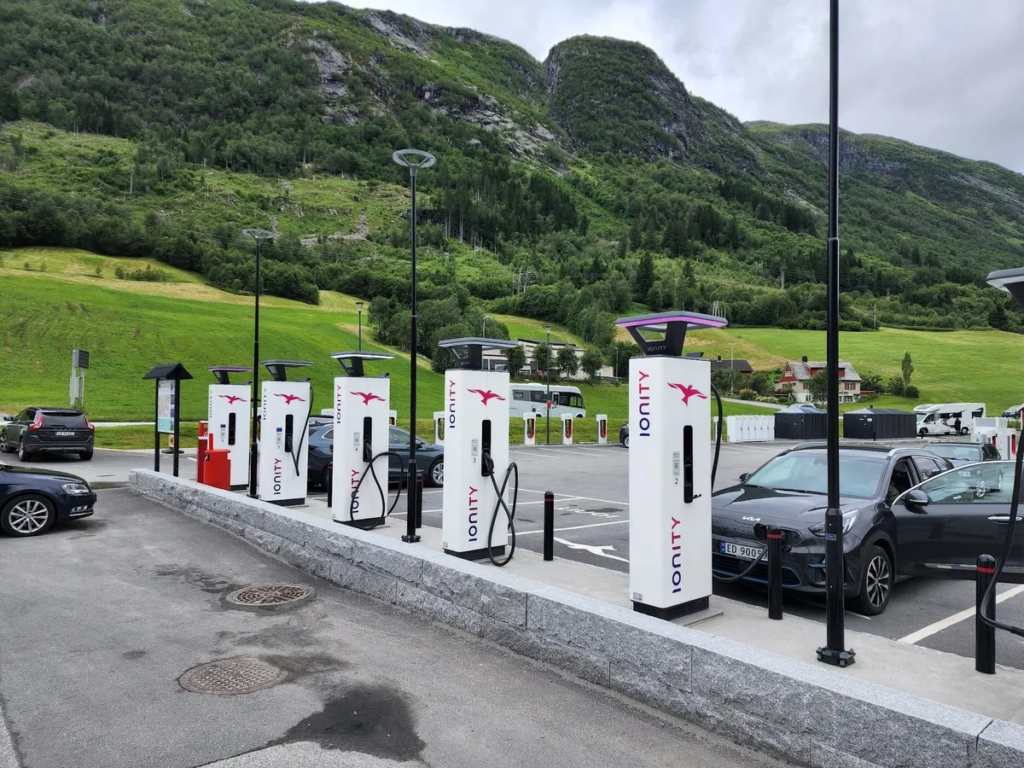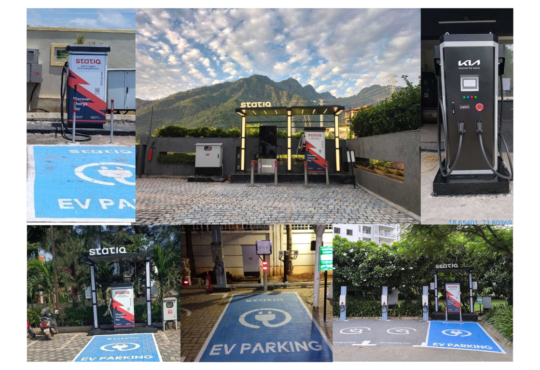
The Environmental Impact of EV Charging: Analyzing the Carbon Footprint of Charging Stations

Why Are Electric Vehicles Taking Over the World?
Electric vehicles (EVs) are gaining popularity across the world as more people are becoming aware of the benefits they offer over traditional gasoline-powered vehicles. EVs are not only environmentally friendly, but they also provide a smoother, quieter ride and require less maintenance than traditional vehicles. With the increase in EV adoption, it’s essential to assess the environmental impact of EVs and charging stations, specifically the carbon footprint of charging stations.
One of the main reasons for the rise in popularity of EVs is their low carbon footprint. EVs emit fewer greenhouse gases than gasoline-powered vehicles, making them an attractive option for those looking to reduce their carbon footprint. However, the carbon footprint of EVs is not just determined by the emissions from the vehicle but also by the emissions from the electricity used to charge the vehicle.
Charging stations play a vital role in the environmental impact of EVs. Charging stations are responsible for providing electricity to EVs, and the source of that electricity can determine the carbon footprint of charging stations. If the electricity comes from renewable sources like wind or solar, the carbon footprint will be low. However, if the electricity comes from fossil fuels like coal or natural gas, then the carbon footprint will be high.
It’s essential to assess the environmental impact of charging stations to ensure that EVs remain an environmentally friendly transportation option. By analyzing the carbon footprint of charging stations, we can identify areas where improvements can be made to reduce the carbon footprint. In this blog, we will explore the environmental impact of EV charging stations by analyzing the carbon footprint of EV chargers. We will also discuss strategies to reduce the carbon impact of the charging stations and understand the government’s role in encouraging sustainable mobility.
Why Is It Important to Assess the Environmental Impact of EVs and Charging Stations?
The carbon footprint of EV charging stations refers to the amount of greenhouse gas emissions associated with the production and distribution of electricity used to charge electric vehicles at the charging stations. The carbon footprint of charging stations is an important factor to consider when evaluating the overall environmental impact of electric vehicles.
Factors Contributing to the Carbon Footprint of EV Charging Stations

Several factors contribute to the carbon footprint of charging stations.
First is the source of the electricity used to power the charging station. If the electricity comes from renewable energy sources such as wind or solar power, the carbon footprint will be lower than if it comes from fossil fuels such as coal or natural gas.
Second, is the efficiency of the charging station. More efficient charging stations require less electricity to charge an electric vehicle, reducing their carbon footprint.
Third, the location of the charging station can also affect its carbon footprint. If the charging station is located in an area with a high concentration of renewable energy sources, its carbon footprint will be lower.
When comparing the carbon footprint of different types of charging stations, there are several key factors to consider.
Level 1 charging stations (AC chargers), which are typically used in residential areas have the lowest carbon footprint because they rely on the existing electrical infrastructure and can be powered by renewable sources such as solar panels.
Level 2 charging stations (Statiq Pillar and Statiq AdWall), which are commonly found in public places such as parking lots and shopping centres, have a slightly higher carbon footprint due to their higher power requirements.
DC fast charging stations, which can charge an EV in as little as 30-45 minutes, have the highest carbon footprint of all charging stations due to their high-power requirements and reliance on the electricity grid.
Overall, the source of electricity, charging station efficiency, and location can all impact the carbon footprint of a charging station. Level 1 charging stations generally have the lowest carbon footprint, while DC fast charging stations have the highest carbon footprint.
By prioritizing the use of renewable energy sources and improving charging station efficiency, we can reduce the carbon footprint of EV charging stations and promote the use of electric vehicles as a more sustainable transportation option.
Environmental Impact of EV Charging

The countries that primarily use coal, natural gas, and oil to generate power will leave a larger carbon footprint as compared to countries using renewable resources such as solar and wind energy.
EV charging stations have the potential to improve air quality by reducing the emissions of greenhouse gases and air pollutants associated with traditional gasoline-powered vehicles. However, it depends on the source of the electricity used to charge the vehicles. If the electricity comes from renewable sources such as wind or solar power, then the impact on air quality will be positive.
However, if the electricity comes from fossil fuels such as coal or natural gas, the environmental impact on air quality will be negative. Charging stations do not typically have a direct impact on water quality. However, the production of electricity can contribute to water pollution if the electricity comes from sources that require water for cooling, such as thermal power plants.
The location of EV charging stations can have an impact on local ecosystems. The construction of new charging stations can disrupt natural habitats and ecosystems, especially if they are located in areas with sensitive ecosystems.
EV charging can also have an impact on energy grids. As the number of EVs on the road increases, there is a risk of overloading the energy grid, especially during peak charging times. To mitigate this, charging infrastructure must be designed to support the increased demand for electricity. This may require upgrades to existing infrastructure and the development of new infrastructure.
How to Reduce the Carbon Footprint of Charging Stations?

Rooftop Solar EV Charging Station Model
Reducing the environmental impact of EV charging is crucial for promoting the widespread adoption of electric vehicles. Here are some strategies that can help reduce the carbon footprint of charging stations:
- Prioritize the Use of Renewable Energy Sources: One of the most effective ways to reduce the carbon footprint of charging stations is to ensure that they are powered by renewable energy sources such as solar and wind energy.
| Pros | Cons |
| This strategy helps to reduce the carbon footprint of charging stations and promotes the use of renewable energy sources. | The cost of installing on-site solar panels can be high, and not all locations are suitable for solar power. |
- Improve Charging Station Efficiency: By increasing the efficiency of charging stations, less electricity is needed to charge an electric vehicle, reducing their carbon footprint. This can be achieved through the use of more efficient charging equipment and smart charging technology that optimizes charging times to reduce electricity demand during peak hours.
| Pros | Cons |
| This strategy helps reduce the carbon footprint of charging stations and can save money on electricity costs. | Upgrading charging infrastructure can be expensive, and not all charging stations may have the necessary infrastructure to support smart charging technology. |
- Encourage the use of off-peak charging: Charging electric vehicles during off-peak hours can help reduce the strain on the energy grid and promote the use of renewable energy sources. This can be achieved through time-of-use pricing that incentivizes charging during off-peak hours.
| Pros | Cons |
| This strategy helps to reduce the strain on the energy grid and promotes the use of renewable energy sources. | The effectiveness of this strategy depends on the availability of time-of-use pricing and may not be feasible for all electric vehicle owners. |
Role of the Indian Government

The Indian government has implemented several policies and initiatives to encourage the adoption of sustainable charging infrastructure for electric vehicles. Some of these policies are:
- Faster Adoption and Manufacturing of (Hybrid &) Electric Vehicles in India (FAME India) Scheme: This scheme aims to promote the adoption of EVs in India by providing subsidies and incentives for the purchase of EVs (electric cars and electric two- & three-wheelers) and the installation of charging infrastructure.
- National Electric Mobility Mission Plan (NEMMP): The NEMMP is a long-term plan to promote the adoption of electric vehicles in India. It includes several measures to encourage the manufacture and adoption of electric vehicles, including incentives for the development of charging infrastructure.
- The National Smart Grid Mission aims to modernize the energy grid in India to support the integration of renewable energy sources and electric vehicles. It includes initiatives to develop smart charging infrastructure that can optimize charging times and reduce the strain on the energy grid.
- Green Urban Transport Scheme (GUTS): The GUTS scheme aims to promote sustainable urban transport by providing funding for the development of electric vehicle charging infrastructure, public transport systems, and non-motorized transport infrastructure.
- Goods and Services Tax (GST) Reduction: In 2019, the Indian government reduced the GST rate on electric vehicles and charging infrastructure from 12% to 5%. This reduction in GST aims to make electric vehicles and charging infrastructure more affordable and accessible for Indian consumers.
How Is Norway Utilizing Renewable Energy to Power EV Charging Stations in the Country?

Norway has been a global leader in the adoption of electric vehicles (EVs) and has been utilizing renewable energy to power its EV charging stations.
Norway has one of the highest shares of renewable energy in its electricity mix, with over 98% of its electricity generated from renewable sources such as hydroelectric power. This means that charging an electric vehicle in Norway has a significantly lower environmental impact compared to other countries where fossil fuels make up a larger share of the electricity mix.
In addition, Norway has been testing innovative solutions for sustainable charging infrastructure, such as wireless charging technology. One example is the “Smart Charging Norway” project, which explores the use of wireless charging technology for electric buses in the city of Oslo. The project aims to reduce the need for physical charging infrastructure and enable more efficient charging of electric buses.
Overall, Norway’s commitment to renewable energy and investment in charging infrastructure has positioned it as a leader in sustainable transportation and a model for other countries to follow.
Other countries working on sustainable charging infrastructure include:
- The Los Angeles Cleantech Incubator (LACI) has set up a network of solar-powered EV charging stations in the city called “Charge Up LA!” These charging stations provide free EV charging to EV owners.
- Amsterdam has set up a network of “fast chargers” for electric vehicles, which are powered by renewable energy sources. These chargers can provide a full charge for an EV in just 20–30 minutes, and they are located in convenient locations around the city.
- California has implemented several policies and incentives to encourage the development of sustainable charging infrastructure, including tax credits for EV charging station installation and grants for low-income communities to install charging stations.
Future of EV Charging and Sustainability

The future of EV charging is expected to be focused on sustainability and convenience. As more countries commit to reducing their carbon footprint and meeting climate goals, there will be a greater emphasis on sustainable charging infrastructure, which is powered by renewable energy sources such as solar, wind, and hydroelectric power.
The continued growth of the electric vehicle market is also expected to drive the development of faster and more efficient charging technologies. With advancements in battery technology and charging infrastructure, it is expected that charging times will continue to decrease, and ranges will continue to increase, making EVs more convenient and practical for long-distance travel.
Overall, the future of EV charging will prioritize sustainability and convenience, with a focus on reducing emissions and increasing efficiency. As the adoption of electric vehicles continues to grow, we can expect to see further advancements and innovations in EV charging technology, making EVs an even more attractive and sustainable option for transportation.
In conclusion, the rise in popularity of EVs is an important step towards reducing greenhouse gas emissions from transportation. However, it’s essential to assess the environmental impact of EVs and charging stations to ensure that they remain an environmentally friendly option.
By analyzing the carbon footprint of charging stations, we can identify areas where improvements can be made to reduce the carbon footprint. Governments and businesses can play a vital role in reducing the carbon footprint of charging stations by incentivizing the use of renewable energy and energy-efficient equipment.
FAQs
Q. What is a carbon footprint?
Ans. Carbon footprint is the amount of greenhouse gas emissions caused by an individual or activity.
Q. What contributes to the carbon footprint of EV charging stations?
Ans. The carbon footprint of EV charging stations comes from the energy used to power them, including the production and transportation of electricity.
Q. How does EV charging impact air and water quality?
Ans. EV charging stations can impact air and water quality through energy production and usage, but overall, they have a lower impact than traditional gasoline stations.
Q. What are some strategies for reducing the environmental impact of EV charging?
Ans. Strategies for reducing the environmental impact of EV charging include using renewable energy sources, smart charging, and energy efficiency measures.
Q. Are there any government policies that encourage the adoption of sustainable charging infrastructure?
Ans. Governments can incentivize the adoption of sustainable charging infrastructure through tax credits, grants, and regulations such as building codes and emission standards.



